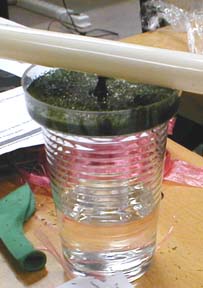Electric Dill

Dill in vegetable oil can be used to show electric fields
Electric Dill

Dill in vegetable oil can be used to show electric fields
Material
Dill
Vegetable oil (or mineral oil)
A plastic petrii dish
A PVC rod
Wool
Assembly
Fill the petrii dish half full of vegetable oil. Sprinkle on dill weed to taste.
The dill will float for many hours but will eventually get saturated with the oil and sink. When it sinks it is less responsive to the electric fields.
To Do and Notice
Rub the PVC rod with wool until it becomes
electrically charged.
(You can hear it crackle as you rub it when it is highly
charged.)
Hold the PVC rod near the dill-in-oil.
Notice that the rod shaped dill lines up with the
electric field of the rod.
Move the rod and watch the dill move.
If you make a thick solution of dill-in-oil and hold the rod close, the dill will gather under the rod and then leap up to "kiss" the rod. You can clean the oily rod with soap and water, and really clean it with rubbing alcohol.
What's Going On?
The dill weed is thin green rods.
These rods will line up with the local electric field.
The dill will line up with the field even when it is in an insulating liquid such as vegetable oil.
The rods of dill have their lowest energy when the positive charges induced in the dill are closest to the negative charges of the PVC rod and the negative charges are furthest away. This happens when the long rod points towards and away from the charges on the rod. That is, when the rod lines up with the electric field.
The charged PVC rod also attracts the dill. Move the rod close enough and the dill and oil can be pulled up against gravity.
An Activity by Paul Doherty,
Thanks to Chamoun Zazi of Sodertalje High School for inventing this activity during electricity class.
|
Scientific Explorations with Paul Doherty |
|
1 Feb 2000 |